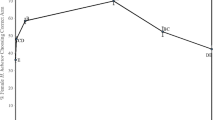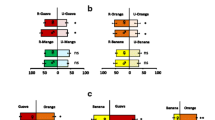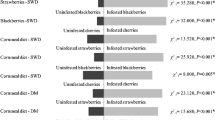Abstract
In South Africa, Thaumatotibia leucotreta is a key pest of citrus impacting its production and trade. Detection of newly infested fruit by visual inspection is challenging and poses a risk of packing infested with healthy fruit for export. Agathis bishopi is a larval endoparasitoid of T. leucotreta, attacking early larval instars. Understanding how A. bishopi parasitoids locate fruit infested with their host is of interest for developing an efficient detector for T. leucotreta infested fruit. The response of female adult A. bishopi parasitoids to olfactory and visual cues associated with T. leucotreta infested fruit were evaluated using a Y-tube olfactometer and flight tunnel. Agathis bishopi parasitoids were strongly attracted to infested fruit over healthy fruit, either when only olfactory or combinations of visual and olfactory cues were offered. Among the four synthetic compounds tested, D-limonene and ocimene elicited a strong attraction to parasitoids with response rates of 92 % and 72 % respectively. A blend of four synthetic compounds simulating T. leucotreta infested fruit odour equally elicited strong attraction to parasitoids (84 % response rate). Attraction of parasitoids to infested fruit cues was heightened by prior experience, suggesting the occurrence of associative learning. Results from this study indicate that A. bishopi parasitoids mainly rely on olfactory cues in host habitat location and that D-limonene and ocimene are the major attractants in infested fruit volatiles. These findings and the potential for manipulating A. bishopi for detection of infested fruit in the packhouse are discussed.


Similar content being viewed by others
References
Belda C, Riudavets J (2010) Attraction of the parasitoid Anisopteromalus calandrae (Howard) (hymenoptera: pteromalidae) to odours from grain and stored product pests in a Y-tube olfactometer. Biol Control 54:29–34
Belda C, Riudavets J (2012) The influence of the rearing host on the response of the parasitoid Venturia canescens (gravenhorst) (hymenoptera: ichneumonidae) to odours from Ephestia kuehniella and Plodia interpunctella in a Y-tube olfactometer. Biol Control 57:801–808
Benelli G, Revadi S, Carpita A, Giunti G, Raspi A, Anfora G, Canale A (2013) Behavioural and electrophysiological responses of the parasitic wasp Psyttalia concolor (szépligeti) (hymenoptera: braconidae) to Ceratitis capitata induced fruit volatiles. Biol Control 64:116–124
Benelli G, Messing RH, Wright MG, Giunti G, Kavallieratos NG, Canale A (2014) Cues triggering mating and host-seeking behaviour in the aphid parasitoid Aphidius colemani (hymenoptera: braconidae: aphidiinae): implications for biological control. J Econ Entomol 107:2005–2022
Bloem S, Carpenter JE, Hofmeyr JH (2003) Radiation biology and inherited sterility in false codling moth (Lepidoptera: tortricidae). J Econ Entomol 96:1724–1731
Boardman L, Grout TG, Terblanche JS (2012) False codling moth Thaumatotibia leucotreta (Lepidoptera: tortricidae) larvae are chill-susceptible. Insect Sci 19:315–328
Canale A, Benelli G (2011) Impact of mass-rearing on the host seeking behaviour and parasitism by the fruit fly parasitoid Psyttalia concolor (szépligeti) (hymenoptera: braconidae). J Pest Sci 85:65–74
Citrus Growers’ Association (CGA), Key Industry Statistics (2013)
Chamberlain K, Briens M, Jacobs JH, Clark SJ, Pickett JA (2012) Use of honey bees Apis mellifera L. to detect the presence of Mediterranean fruit fly Ceratitis capitata wiedemann larvae in Valencia oranges. J Sci Food Agric 92:2050–2054
Coombes CA, Hill MP, Moore SD, Dames JF, Fullard T (2013) Persistence and virulence of promising entomopathogenic fungal isolates for use in citrus orchards in South Africa. Biocontrol Sci Tech 23:1053–1066
Core Team R (2013) R: a language and environment for statistical computing. R Foundation for Statistical Computing, Vienna
Costa A, Richard I, Davison AC, Turlings TC (2010) Effects of rewarding and unrewarding experiences on the response to host-induced plant odours of the generalist parasitoid Cotesia marginiventris (hymenoptera: braconidae). J Insect Behav 23:303–318
Daisy BH, Strobel GA, Castillo U, Ezra D, Sears J, Weaver DK, Runyon JB (2002) Naphthalene, an insect repellent, is produced by Muscodor vitigenus, a novel endophytic fungus. Microbiology 148:3737–3741
Degenhardt J, Hiltpold I, Köllner TG, Frey M, Gierl A, Gershenzon J, Hibbard BE, Ellersieck MR, Turlings TC (2009) Restoring a maize root signal that attracts insect-killing nematodes to control a major pest. Proc Natl Acad Sci 106:13213–13218
Desouhant E, Driessen G, Amat I, Bernstein C (2005) Host and food searching in a parasitic wasp Venturia canescens: a trade-off between current and future Reproduction? Anim Behav 70:145–152
Dias VS, Stuhl C, Sivinski J (2014) Effects of a fruit and a host-derived compound on orientation and oviposition in Utetes anastrephae, a little studied opiine braconid (hymenoptera) parasitoid of Anastrepha spp. fruit flies (diptera: tephritidae). Biocontrol Sci Tech 24:1412–1424
Eben A, Benrey B, Sivinski J, Aluja M (2000) Host species and host plant effects on preference and performance of Diachasmimorpha longicaudata (hymenoptera: braconidae). Environ Entomol 29:87–94
Ero MM, Neale CJ, Hamacek E, Peek T, Clarke AR (2011) Preference and performance of Diachasmimorpha kraussii (fullaway) (hymenoptera: braconidae) on five commercial fruit species. J Appl Entomol 135:214–224
Fatouros NE, van Loon JJ, Hordijk KA, Smid HM, Dicke M (2005) Herbivore-induced plant volatiles mediate in-flight host discrimination by parasitoids. J Chem Ecol 31:2033–2047
Fisher K, Phillips C (2008) Potential antimicrobial uses of essential oils in food: is citrus the answer? Trends Food Sci Technol 19:156–164
Galera MM, Vázquez PP, Vidal JM, Fernández JM, Gómez JP (2004) Large-volume direct injection for determining naphthalene derivative pesticides in water using a restricted-access medium column in RPLC-LC with fluorescence detection. Chromatographia 60:517–522
Gandolfi M, Mattiacci L, Dorn S (2003) Mechanisms of behavioural alterations of parasitoids reared in artificial systems. J Chem Ecol 29:1871–1887
Gendall K (2007) Agathis bishopi (Nixon) (hymenoptera: braconidae): its biology and usefulness as a biological control agent for false codling moth (FCM), Thaumatotibia leucotreta (Meyrick) (Lepidoptera: tortricidae), on citrus. Rhodes University, Dissertation
Georgala MB (1969) Control of false codling moth and fruit flies in citrus orchards. South African Fruit J 421:3–7
Giunti G, Canale A, Messing RH, Donati E, Stefanini C, Michaud JP, Benelli G (2015) Parasitoid learning: current knowledge and implications for biological. Biological control 90:208–219
Graziosi I, Rieske LK (2013) Response of Torymus sinensis, a parasitoid of the gallforming Dryocosmus kuriphilus, to olfactory and visual cues. Biol Control 67:137–142
Hare JD (2011) Ecological role of volatiles produced by plants in response to damage by herbivorous insects. Annu Rev Entomol 56:161–180
Hosni K, Zahed N, Chrif R, Abid I, Medfei W, Kallel M, Brahim NB, Sebei H (2010) Composition of peel essential oils from four selected Tunisian Citrus species: evidence for the genotypic influence. Food Chem 123:1098–1104
Huang M, Sanchez-Moreiras AM, Abel C, Sohrabi R, Lee S, Gershenzon J, Tholl D (2012) The major volatile organic compound emitted from Arabidopsis thaliana flowers, the sesquiterpene (E)-β-caryophyllene, is a defence against a bacterial pathogen. New Phytol 193:997–1008
Johnson SA, Neven LG (2010) Potential of heated controlled atmosphere postharvest treatments for the control of Thaumatotibia Leucotreta (Lepidoptera: tortricidae). J Econ Entomol 103:265–271
Johnson TD, Lelito JP, Raffa KF (2014) Responses of two parasitoids, the exotic Spathius agrili yang and the native Spathius floridanus Ashmead, to volatile cues associated with the emerald ash borer, Agrilus planipennis fairmaire. Biol Control 79:110–117
Kaplan I (2012) Attracting carnivorous arthropods with plant volatiles: the future of biocontrol or playing with Fire? Biol Control 60:77–89
Kendra PE, Roda AL, Montgomery WS, Schnell EQ, Niogret J, Epsky ND, Heath RR (2011) Gas chromatography for detection of citrus infestation by fruit fly larvae (diptera: tephritidae). Postharvest Biol Technol 59:143–149
Leitch O, Anderson A, Kirkbride KP, Lennard C (2013) Biological organisms as volatile compound detectors: a review. Forensic Sci Int 232:92–103
Li H, Bouwer G (2012) The larvicidal activity of Bacillus thuringiensis cry proteins against Thaumatotibia leucotreta (Lepidoptera: tortricidae). Crop Prot 32:47–53
Love CN, Hill MP, Moore SD (2014) Thaumatotibia leucotreta and the navel orange: ovipositional preferences and host susceptibility. J Appl Entomol 138:600–611
Malan AP, Knoetze R, Moore SD (2011) Isolation and identification of entomopathogenic nematodes from citrus orchards in South Africa and their biocontrol potential against false codling moth. J Invertebr Pathol 8:115–125
Mattiacci L, Hütter E, Dorn S (1999) Host location of Hyssopus pallidus, a larval parasitoid of the codling moth, Cydia pomonella. Biol Control 15:241–251
Mazza G, Strangi A, Marinelli L, Del Nista D, Roversi PF (2014) Thaumatotibia leucotreta (Meyrick) (Lepidoptera tortricidae) intercepted for the first time in Italy. Redia 97:147–149
McCormick AC, Unsicker SB, Gershenzon J (2012) The specificity of herbivore-induced plant volatiles in attracting herbivore enemies. Trends Plant Sci 17:303–310
Moore SD (2002) The development and evaluation of Cryptophlebia leucotreta granulovirus (CrleGV) as a biological control agent for the management of false codling moth, Cryptophlebia leucotreta, on citrus. Rhodes University, Dissertation
Moore SD, Kirkman W, Stephen P (2004) Cryptogran, a virus for the biological control of false codling moth. South African Fruit J 3:35–39
Moore SD, Richards GI, Chambers C, Hendry D (2014) An improved larval diet for commercial mass rearing of the false codling moth, thaumatotibia leucotreta (Meyrick) (Lepidoptera: tortricidae): short communication. African Entomol 22:216–219
Newton P J (1998) Lepidoptera: Butterflies and Moths. In: Citrus pests in the Republic of South Africa, 2nd edn. Institute for Tropical and Subtropical Crops, pp 194–200
Ngumbi E, Jordan M, Fadamiro H (2012) Comparison of associative learning of host-related plant volatiles in two parasitoids with different degrees of host specificity, Cotesia marginiventris and Microplitis croceipes. Chemoecology 22:207–215
Obonyo M, Schulthess F, Le Ru B, Van den Berg J, Silvain JF, Calatayud PA (2010) Importance of contact chemical cues in host recognition and acceptance by the braconid larval endoparasitoids Cotesia sesamiae and Cotesia flavipes. Biol Control 54:270–275
Olson D, Rains G (2014) Use of a parasitic wasp as a biosensor. Biosensors 4:150–160
Opoku-Debrah JK, Hill MP, Knox C, Moore SD (2013) Overcrowding of false codling moth, Thaumatotibia leucotreta (Meyrick) leads to the isolation of five new Cryptophlebia leucotreta granulovirus (CrleGV-SA) isolates. J Invertebr Pathol 112:219–228
Paré PW, Tumlinson JH (1999) Plant volatiles as a defence against insect herbivores. Plant Physiol 121:325–332
Robert CAM, Erb M, Hiltpold I, Hibbard BE, Gaillard MDP, Bilat J, Degenhardt J, Cambet-Petit-Jean X, Christiaan T, Turlings J, Zwahlen C (2013) Genetically engineered maize plants reveal distinct costs and benefits of constitutive volatile emissions in the field. Plant Biotechnol J 11:628–639
Rogers ME, Potter DA (2002) Kairomones from scarabaeid grubs and their frass as cues in below-ground host location by the parasitoids Tiphia vernalis and Tiphia pygidialis. Entomologia Experimentalis et Applicata 102:307–314
Rojas JC, Castillo A, Virgen A (2006) Chemical cues used in host location by Phymastichus coffea, a parasitoid of coffee berry borer adults, Hypothenemus hampei. Biol Control 37:141–147
Sabrina M, D'Adamo P, Lozada M (2014) The influence of past experience on wasp choice related to foraging behaviour. Insect Sci 21:759–764
Sasso R, Iodice L, Cristina Digilio M, Carretta A, Ariati L, Guerrieri E (2007) Host-locating response by the aphid parasitoid Aphidius ervi to tomato plant volatiles. J Plant Interact 2:175–183
Segura DF, Viscarret MM, Ovruski SM, Cladera JL (2012) Response of the fruit fly parasitoid Diachasmimorpha longicaudata to host and host-habitat volatile cues. Entomologia Experimentalis et Applicata 143:164–176
Smith WEC, Shivaji R, Williams WP, Luthe DS, Sandoya GV, Smith CL, Sparks DL, Brown AE (2012) A maize line resistant to herbivory constitutively releases (E)-β-caryophyllene. J Econ Entomol 105:120–128
Steidle JL, Schöller M (2002) Fecundity and ability of the parasitoid Lariophagus distinguendus (hymenoptera: pteromalidae) to find larvae of the granary weevil Sitophilus granaries (coleoptera: curculionidae) in bulk grain. J Stored Prod Res 38:43–53
Stibick J (2008) New pest response guidelines: false codling moth Thaumatotibia leucotreta. http://www.aphis.usda.gov/import_export/plants/manuals/emergency/downloads/nprg-fcm.pdf. Accessed 3 August 2008
Stofberg FJ (1954) False codling moth of citrus. Farming in South Africa, June 1954: pp 273–276
Ulyett GC (1939) Parasites of the false codling moth Argyroploce leucotreta in South Africa. Proc Entomol Conf, August 22–24, Union Buildings, pp 54–55
Van der Walt R (2012) Identifying volatile emissions associated with false codling moth infested citrus fruit. Nelson Mandela Metropolitan University, Dissertation
Wäckers F, Olson D, Rains G, Lundby F, Haugen JE (2011) Boar taint detection using parasitoid biosensors. J Food Sci 76:41–47
Wang XY, Yang ZQ, Gould JR, Wu H, Ma JH (2010) Host-seeking behaviour and parasitism by Spathius agrili yang (hymenoptera: braconidae), a parasitoid of the emerald ash borer. Biol Control 52:24–29
Yu H, Zhang Y, Wyckhuys KA, Wu K, Gao X, Guo Y (2010) Electrophysiological and behavioural responses of Microplitis mediator (hymenoptera: braconidae) to caterpillar-induced volatiles from cotton. Environ Entomol 39:600–609
Zimba K, Moore SD, Heshula U, Hill MP (2016) Agathis bishopi, a larval parasitoid of false codling moth Thaumatotibia leucotreta: laboratory rearing and effect of adult food on parasitism and longevity. African Entomology 24(in press)
Acknowledgments
The authors extend their gratitude to Citrus Research International (CRI), the NRF, South Africa Research Chair Initiative in Applied Entomology at Rhodes University and Maastricht University for financial assistance towards this work. Technical help from Wayne Kirkman (CRI), John Opoku-Debrah (CRI), Tanya Pretorius (Rhodes University), Mellissa Peyper (Rhodes University) and Craig Chambers (River Bioscience) is greatly appreciated. The helpful comments by the anonymous reviewers are greatly appreciated. Authors further express their appreciation to the farmers in the Sundays River Valley (Eastern Cape Province, South Africa) for providing fruit for this study.
Author information
Authors and Affiliations
Corresponding author
Ethics declarations
Insects used in this study were collected according to the guidelines as stipulated in the permit: CRO 12/14CR and CRO 13/14CR from the Department of Economic Development, Environmental affairs and Tourism, Eastern Cape Province, South Africa.
Conflict of Interest
We declare that there are no potential conflicts of interest in this work.
Rights and permissions
About this article
Cite this article
Zimba, K., Hill, M.P., Moore, S.D. et al. Agathis bishopi (Hymenoptera: Braconidae) as a Potential Tool for Detecting Oranges Infested with Thaumatotibia leucotreta (Lepidoptera: Tortricidae). J Insect Behav 28, 618–633 (2015). https://doi.org/10.1007/s10905-015-9526-0
Revised:
Accepted:
Published:
Issue Date:
DOI: https://doi.org/10.1007/s10905-015-9526-0




